Chainsaw Man is a brutally honest and action-packed manga that has captivated fans worldwide. Its unique blend of dark humor, shocking violence, and endearing characters has made it a modern classic. However, if you’ve finished the series and are craving more manga with similar elements, you’re in luck! KomikPDF Lovers, we’ve compiled a list of manga that share the same compelling qualities as Chainsaw Man, offering exciting stories and memorable characters.
These recommendations, based on extensive research from KomikPDF.com, dive into the thrilling worlds of manga that explore themes of love, betrayal, and the struggle for survival. Whether you’re drawn to the visceral action, the complex character development, or the unique art style, you’ll find a new series to obsess over. Get ready to discover darker themes, intense fights, and unexpected twists that will keep you hooked until the very last page.
So, buckle up, KomikPDF Lovers, because we’re about to embark on a journey through the world of manga that will leave you wanting more. From gritty anti-heroes to heart-wrenching stories of redemption, this list will introduce you to titles that deserve a place on your reading list. Prepare to be amazed by the depth and diversity of the manga world, all while experiencing the same thrilling and unforgettable journey that Chainsaw Man has provided.
Synopsis Chainsaw Man
In a world where devils are born from the fear of humans, Denji is a young man who lives a miserable life. After his father’s death, he is forced to work for the Yakuza, taking on dangerous missions to pay off his father’s debts. Denji’s only companion is Pochita, a chainsaw devil that he inherited from his father.
One day, Denji is betrayed and killed by the Yakuza, but Pochita fuses with his heart, bringing him back to life as a new being: Chainsaw Man. With his newfound abilities, Denji is recruited into the Public Safety Devil Hunters, a group of demon hunters who fight to protect humanity from devil threats.
Chainsaw Man follows Denji’s journey as he navigates the dangerous world of devil hunters, facing off against powerful devils, forming alliances with other hunters, and struggling with his own inner demons. Through his experiences, Denji learns about the true nature of power, the meaning of loyalty, and the complexities of humanity.
Jujutsu Kaisen

Both Jujutsu Kaisen and Chainsaw Man are dark fantasy action series with compelling characters and engaging storylines. They both feature protagonists who have to deal with supernatural entities and have to make difficult choices. While Jujutsu Kaisen focuses more on the world of curses and the training of exorcists, Chainsaw Man explores themes of love, loss, and the nature of power through its protagonist’s journey. Both series are known for their stylish visuals, thrilling action sequences, and complex characters who struggle with their own inner demons. Despite their differences, both Jujutsu Kaisen and Chainsaw Man offer a unique blend of action, drama, and horror that makes them popular among fans of the genre.
Synopsis Jujutsu Kaisen
Jujutsu Kaisen follows the story of Yuji Itadori, a seemingly ordinary high school student with incredible physical strength. His life takes an unexpected turn when he encounters a cursed object, a finger belonging to the powerful sorcerer, Ryomen Sukuna. Upon consuming the finger, Yuji becomes a vessel for Sukuna and is thrust into the world of Jujutsu sorcery.
Now, under the guidance of Satoru Gojo, a powerful and eccentric sorcerer, Yuji attends the Tokyo Metropolitan Jujutsu High School. He trains alongside other students, including the brilliant but cold Megumi Fushiguro and the enigmatic Nobara Kugisaki. As Yuji learns to control his newfound powers and the malevolent Sukuna within, he faces increasingly dangerous curses and uncovers the secrets of Jujutsu sorcery. His journey takes him to confront the dark forces threatening the world, and he must fight to save both his own soul and the lives of others.
Tokyo Ghoul
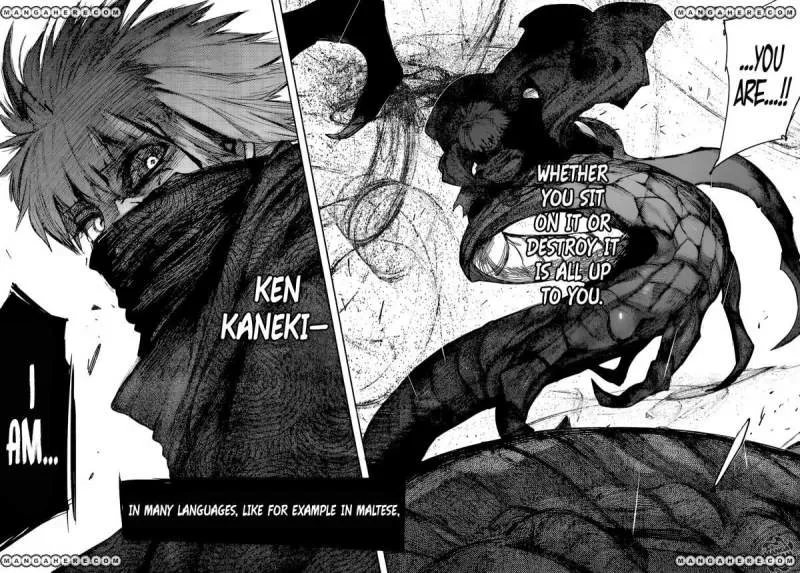
Both Tokyo Ghoul and Chainsaw Man delve into the themes of survival, societal prejudice, and the blurred lines between humanity and monstrosity. Both series feature protagonists who are caught between two worlds, forced to confront the darkness within themselves and the prejudice they face from the world around them. They explore the psychological toll of violence and the struggle to maintain one’s humanity in the face of overwhelming odds. While their visual styles and specific themes differ, both series offer a captivating blend of action, horror, and philosophical commentary on the human condition, making them compelling reads for fans of dark and complex narratives.
Synopsis Tokyo Ghoul
Ken Kaneki is a normal college student who lives a quiet life. One day, he gets attacked by a ghoul, a creature that feeds on human flesh. He survives the attack, but not without consequences. A ghoul's organ is transplanted into his body, transforming him into a ghoul himself. Kaneki now struggles with his new identity, trying to live a normal life while battling his own hunger and the discrimination faced by ghouls.
As Kaneki navigates this dangerous world, he meets Rize Kamishiro, the ghoul who attacked him. Rize becomes his mentor, teaching him how to survive and use his ghoul powers. However, their relationship is complicated by the fact that Rize is a powerful ghoul who wants to destroy humanity. Kaneki must choose between his humanity and his ghoul identity, while fighting to protect the humans he loves.
Attack on Titan
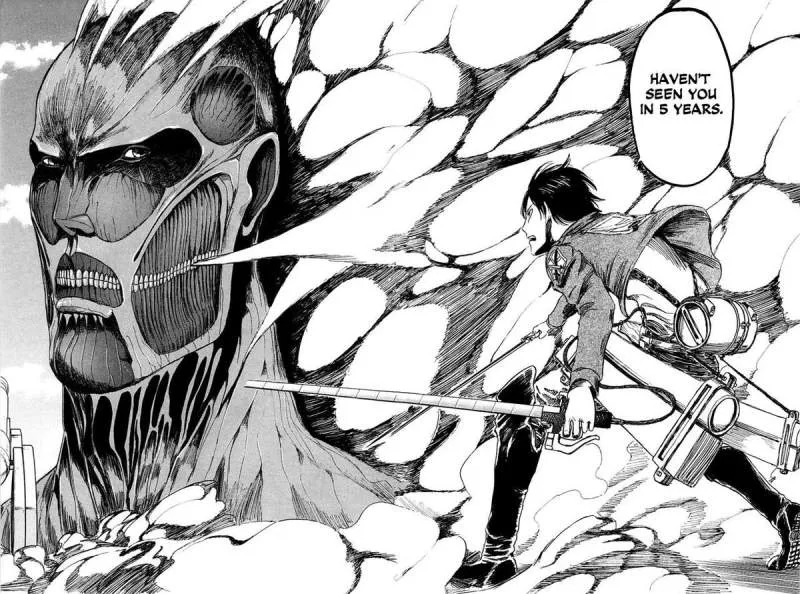
While seemingly disparate in their initial presentations, Attack on Titan and Chainsaw Man share surprising thematic similarities. Both series explore the consequences of living in a world defined by violence and fear, with protagonists forced to confront their own humanity amidst brutal realities. They delve into the complexities of power and the moral compromises made in the face of overwhelming threats. Furthermore, both series feature a unique blend of action, dark humor, and philosophical introspection, challenging the audience to grapple with profound questions about the nature of good and evil. Despite their distinct visual styles and genre conventions, both Attack on Titan and Chainsaw Man leave a lasting impact on the reader, prompting reflections on the human condition in a world fraught with conflict and uncertainty.
Synopsis of Attack on Titan
In a world surrounded by three concentric walls, humanity lives in fear of the Titans, gigantic humanoid creatures that devour humans. The story follows Eren Yeager, a young boy whose life changes forever after the outer wall is breached by the Colossal Titan, a 60-meter-tall Titan that unleashes chaos. Driven by a burning desire for revenge, Eren vows to exterminate all Titans after witnessing his mother's brutal death. He enlists in the Survey Corps, an elite military unit tasked with fighting the Titans beyond the walls.
Eren and his companions face perilous missions outside the walls, encountering various types of Titans, each with unique abilities. They uncover secrets about the world, their history, and the true nature of the Titans. As they fight for survival, Eren discovers he possesses the power of the Attack Titan, a special ability that allows him to transform into a Titan himself. This power becomes a crucial weapon in the fight against the Titans, but it also brings with it its own set of challenges and moral dilemmas.
Dorohedoro
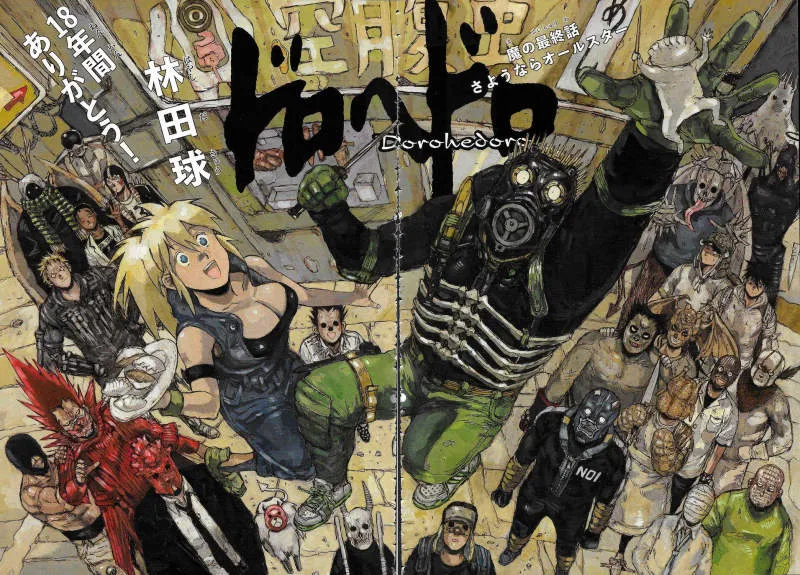
Both Dorohedoro and Chainsaw Man are dark fantasy manga series that share several common themes and stylistic elements. Both series feature a strong sense of violence and gore, with brutal fight scenes and disturbing imagery. The protagonists are both outsiders who are trying to find their place in a world that is indifferent to their struggles. Both series also feature unique and memorable characters, as well as a blend of dark humor and tragedy. While Dorohedoro focuses on a more grounded, urban setting, Chainsaw Man dives into a world of supernatural beings and political conspiracies. Both manga have a distinctive art style, with bold lines and expressive character designs, but Dorohedoro leans more toward a gritty realism, while Chainsaw Man features a more stylized and grotesque aesthetic.
Synopsis Dorohedoro
Dorohedoro is a dark fantasy manga that takes place in a world divided between the "Hole," a rundown district inhabited by humans, and the "Sorcery District," where magic users reside. The story follows Caiman, a human with a reptilian head who has lost his memories. He is on a quest to find the sorcerer who cursed him and reclaim his human form. To achieve this, he is accompanied by Nikaido, a tough, kind-hearted woman who works as a mercenary.
While searching for his curse's origin, Caiman encounters various characters, both human and sorcerers, with unique abilities and motivations. As he delves deeper into the mysteries surrounding the sorcerers and the Hole, he discovers a conspiracy that threatens both worlds. The manga explores themes of identity, memory, and the consequences of magic and power. With its gritty art style and complex characters, Dorohedoro offers a thrilling and captivating journey through a world filled with magic, mystery, and violence.
Fire Punch
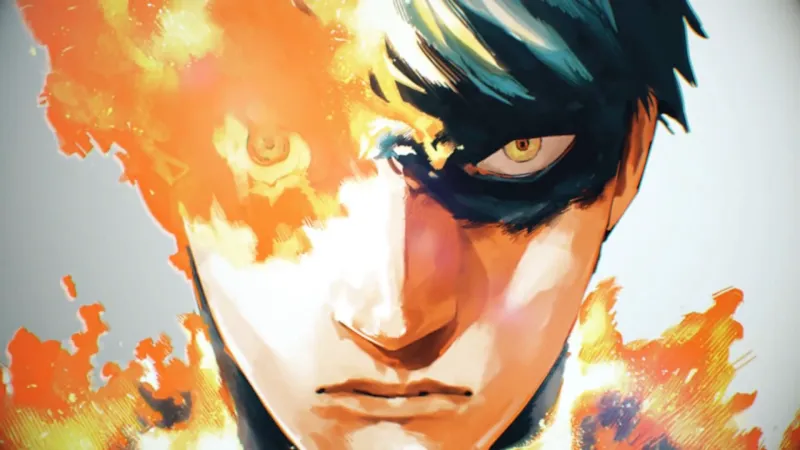
Both Fire Punch and Chainsaw Man are dark fantasy manga that explore themes of violence, trauma, and the human condition. They both feature protagonists with unique and gruesome abilities, who are forced to confront the horrors of their world. The protagonists, Agni in Fire Punch and Denji in Chainsaw Man, are both deeply troubled individuals, haunted by their past and seeking redemption in a cruel and unforgiving world. Both series feature graphic violence and disturbing imagery, but also incorporate elements of humor and character development. Both mangas are praised for their distinctive art styles, compelling stories, and complex characters.
Synopsis Fire Punch
Fire Punch is a dark fantasy manga series written and illustrated by Fujimoto Tatsuki. The story is set in a world ravaged by a mysterious, supernatural force known as "The Ashen Flame," which consumes everything in its path, leaving behind only ash and destruction. The protagonist, Agni, is a young man cursed with the ability to regenerate from any injury, even if his body is completely incinerated. This power, however, comes at a terrible price, as Agni is forever trapped in a cycle of death and rebirth, constantly reliving the horrors of the Ashen Flame.
The story follows Agni as he seeks to understand the true nature of the Ashen Flame and find a way to end the cycle of suffering it has unleashed upon the world. Along the way, he encounters a cast of intriguing and often tragic characters, each with their own unique motivations and struggles. The manga explores themes of loss, redemption, and the nature of humanity in the face of overwhelming despair.
Berserk
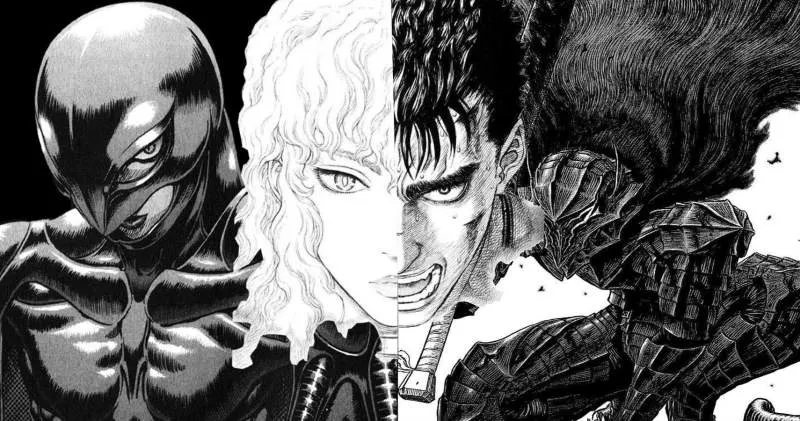
Both Berserk and Chainsaw Man are dark fantasy manga series that explore themes of violence, survival, and the human condition. Both feature protagonists with supernatural powers who are forced to fight against monstrous creatures and corrupt forces. However, despite their similarities, they also have distinct differences. Berserk is more grounded in medieval fantasy with a focus on complex characters and political intrigue. Chainsaw Man, on the other hand, is more modern and uses a more comedic approach to its dark themes. Both series offer unique takes on the fantasy genre, blending brutal action with complex characters and thought-provoking stories.
Synopsis Berserk
Berserk is a dark fantasy manga series written and illustrated by Kentaro Miura. It follows the story of Guts, a lone mercenary known as the "Black Swordsman." He travels the world, fighting and surviving, haunted by the demons that plague him since his childhood and the horrors he witnessed in the war against the God Hand.
Guts is thrust into a world of magic and monsters, where he faces formidable foes and forms alliances with unlikely companions. He seeks revenge against the God Hand, who cursed him with a mark that attracts demons. The story is filled with brutality, violence, and deep themes of survival, loss, and the human condition.
Devilman
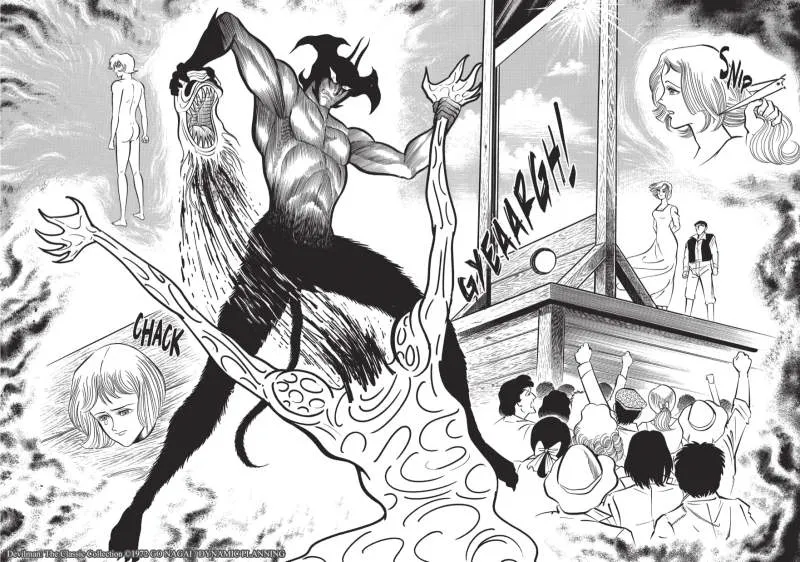
The manga series Devilman and Chainsaw Man, while distinct in their own right, share a striking thematic resemblance. Both stories center around protagonists burdened with immense power derived from demonic entities. This power comes at a great cost, forcing them to grapple with their own humanity and the ethical implications of wielding such immense force. Both stories explore themes of existentialism, the nature of good and evil, and the inherent brutality of the world. Additionally, both feature compelling and dynamic character designs, capturing the essence of the characters through both their physical appearance and their complex inner struggles. This thematic synergy makes both series compelling reads for fans of dark and thought-provoking stories that explore the human condition in the face of overwhelming power.
Synopsis Devilman
In a world where demons lurk in the shadows, Akira Fudo, a kind-hearted teenager, discovers his own demonic heritage when he fuses with a demon named Amon. As Devilman, Akira possesses immense power and the ability to fight against the demonic forces that threaten humanity. He teams up with his childhood friend, Ryo Asuka, a journalist who is determined to expose the truth about the demonic invasion.
Devilman's journey takes him through a dark and terrifying world filled with monstrous creatures and ruthless demons. As he battles for survival, Akira must confront his own inner demons and the moral complexities of his existence. The manga explores themes of humanity, good and evil, and the consequences of power in a world where the lines between human and demon are blurred.
Hellsing
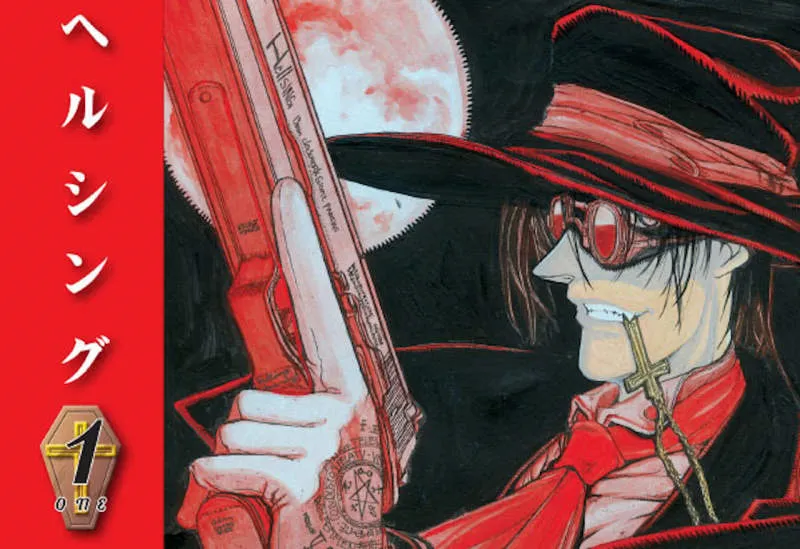
While seemingly disparate in tone and genre, Hellsing and Chainsaw Man share a surprising amount of thematic and stylistic similarities. Both series feature protagonists with a complex relationship to their power, struggling to maintain control over their monstrous abilities while facing existential threats that challenge the very fabric of their world. Both series also feature striking visual aesthetics, showcasing a blend of gritty realism and over-the-top action that captivates the reader. Moreover, the series both deal with themes of identity, morality, and the consequences of power, making them compelling explorations of the human condition.
Synopsis of Hellsing
Hellsing is a dark fantasy manga series written and illustrated by Kouta Hirano. The story takes place in a world where vampires and other supernatural creatures exist, and follows the adventures of the Hellsing Organization, a secret society dedicated to protecting England from these threats. The organization's primary weapon is Alucard, a powerful vampire who serves as the organization's ultimate weapon against supernatural foes.
The story begins with the arrival of a group of powerful vampires in England, led by the enigmatic Walter C. Dornez. As the vampires begin to wreak havoc, Integra Hellsing, the head of the Hellsing Organization, calls upon Alucard to stop them. As the battle rages on, the lines between good and evil become blurred, and the true nature of the Hellsing Organization and its purpose are slowly revealed.
Claymore
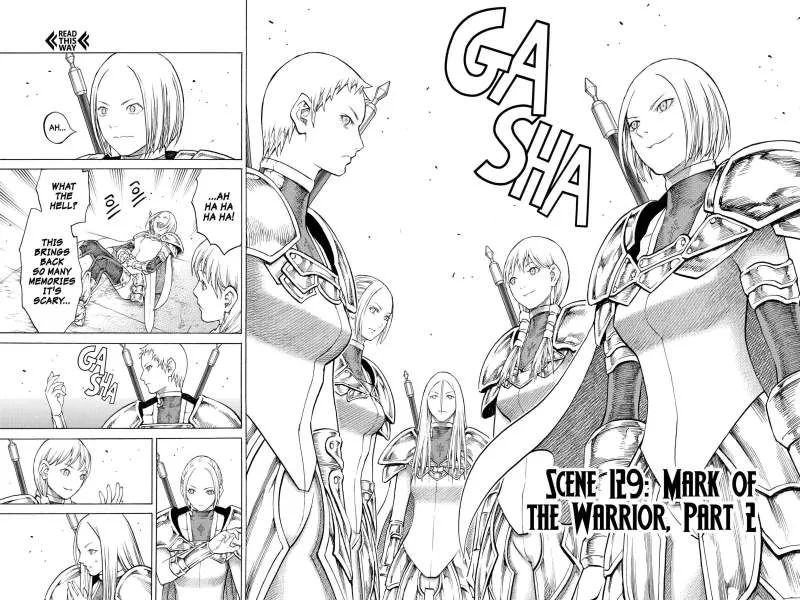
While both Claymore and Chainsaw Man are popular action-packed manga series with supernatural elements, they share several notable similarities. Both series feature powerful female protagonists who fight against monstrous beings, with Yumi from Claymore and Power from Chainsaw Man both initially displaying a fierce and independent personality. Both series also delve into the complexities of humanity and monsterhood, exploring themes of sacrifice, loyalty, and the moral gray areas that arise when dealing with powerful and dangerous beings. While their artistic styles differ, both manga series offer visually stunning action sequences and compelling character development, leaving readers on the edge of their seats.
Synopsis: Claymore
Claymore is a dark fantasy manga series that follows the journey of Claymores, female warriors who are half-human and half-yoma, trained to exterminate the yoma, monstrous creatures that prey on humans. Clare, the protagonist, is a Claymore who seeks revenge against the yoma that destroyed her village. She is accompanied by Raki, a young man who survived the attack and vows to help her on her journey.
The story delves into the complex relationship between humans and Claymores, the ethical dilemmas of fighting against their own kind, and the sacrifices made in the pursuit of justice. The Claymores are constantly hunted by the Organization, a shadowy group that controls their lives, and they must navigate a world where fear and prejudice are rampant.
Blue Exorcist
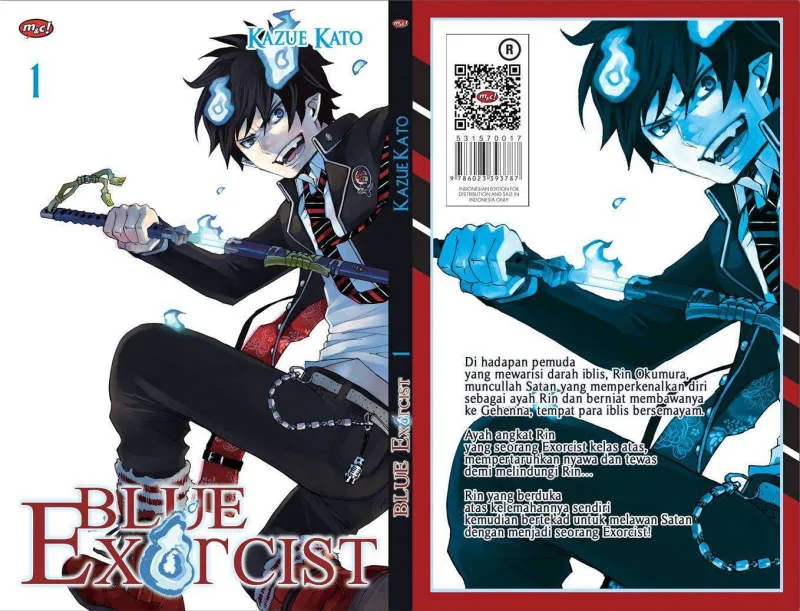
Both Blue Exorcist and Chainsaw Man are popular manga series that feature protagonists with supernatural powers battling against demonic forces. While their settings and art styles differ, both series explore themes of family, redemption, and the struggles of living in a world where the line between good and evil is blurred. Rin Okumura from Blue Exorcist and Denji from Chainsaw Man share similar motivations: a desire to protect those they care about and a willingness to sacrifice themselves for the greater good. The stories also feature complex characters with tragic backstories, adding depth and emotional resonance to their struggles. These similarities, combined with their exciting action sequences and compelling narratives, make both Blue Exorcist and Chainsaw Man engaging reads for fans of dark fantasy and supernatural action.
Synopsis Blue Exorcist
Blue Exorcist is a Japanese manga series written and illustrated by Kazue Kato. It follows the story of Rin Okumura, a seemingly ordinary teenager who discovers that he is the son of Satan, the demon king. After his adoptive father, Father Fujimoto, is killed by Satan, Rin decides to become an Exorcist to fight demons and avenge his father's death. He enrolls in True Cross Academy, a school for Exorcists, where he trains to hone his powers and learn the secrets of his demonic heritage.
Rin's journey is not without its challenges, as he struggles to control his demonic powers while battling the forces of evil. He is joined by his younger brother, Yukio, who is also an Exorcist, and his classmates, who become his allies and friends. The manga explores themes of family, identity, and the battle between good and evil, as Rin grapples with his destiny and the responsibility of protecting the world from demonic forces.
Demon Slayer: Kimetsu no Yaiba
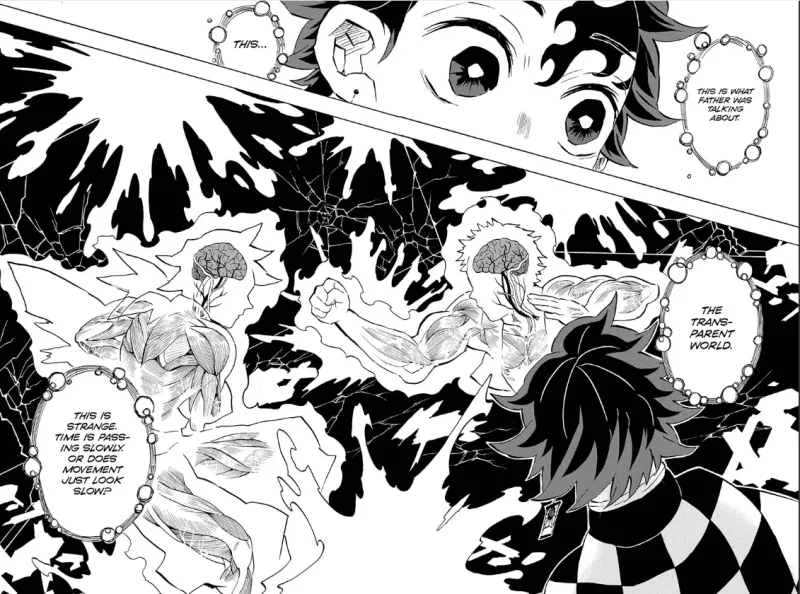
The two popular manga series, Demon Slayer: Kimetsu no Yaiba and Chainsaw Man, share several similarities that make them appealing to fans of action, adventure, and supernatural themes. Both feature protagonists with unique powers that come at a cost. Tanjiro Kamado from Demon Slayer inherits a demon slayer’s swordsmanship and supernatural senses after his family is massacred, while Denji from Chainsaw Man gains the ability to transform into a chainsaw devil after making a pact with Pochita. Both stories explore themes of loss, grief, and the struggle for survival in a world filled with danger and supernatural entities. Moreover, both series showcase a blend of intense action sequences, humor, and character development, creating compelling narratives that leave readers on the edge of their seats.
Synopsis Demon Slayer: Kimetsu no Yaiba
Tanjiro Kamado is a kindhearted young boy who lives with his family in the mountains. One day, tragedy strikes when his family is slaughtered by a demon. Tanjiro's younger sister Nezuko is the only survivor, but she has been transformed into a demon. Determined to find a cure for his sister and avenge his family, Tanjiro sets out on a journey to become a Demon Slayer.
Tanjiro joins the Demon Slayer Corps, an organization that protects humanity from demons. He trains under the guidance of the experienced Demon Slayer, Sakonji Urokodaki. Along his journey, Tanjiro encounters other Demon Slayers, each with their own unique abilities and motivations. He also faces powerful demons, each with their own tragic backstories.
Hell’s Paradise: Jigokuraku
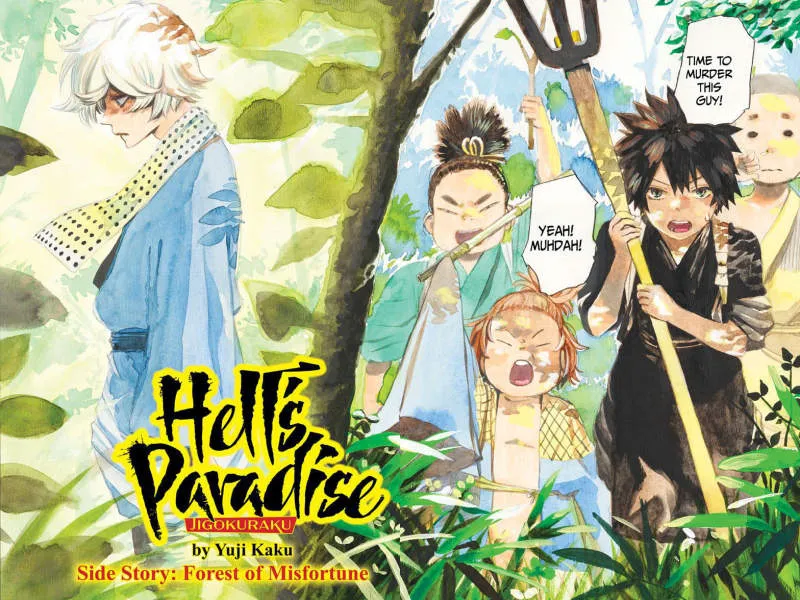
While both Chainsaw Man and Hell’s Paradise: Jigokuraku feature protagonists who are initially driven by self-serving motives, the two series share a common thematic thread. Both stories explore the nature of good and evil, questioning the very definitions of what constitutes a hero or a villain. Both explore a world saturated with violence and the complex ethical dilemmas that arise from it. The protagonists, despite their initial selfishness, ultimately find themselves on a path towards self-discovery and redemption. Both series challenge the reader to question their own perceptions of morality and the nature of human nature.
Synopsis Hell's Paradise: Jigokuraku
Hell's Paradise: Jigokuraku is a Japanese manga series written and illustrated by Yuji Kaku. The story follows Gabimaru the Hollow, a highly skilled ninja who is sentenced to death for treason. However, he is given a chance to regain his freedom by being sent to a cursed island called "Shinjuku Island" (or "The Island of Immortals"). This island is rumored to be home to the elixir of immortality, a coveted item sought by the shogun. Gabimaru is tasked with finding the elixir and bringing it back to the shogun in exchange for his freedom.
Gabimaru reluctantly embarks on this dangerous mission, facing a variety of threats, including the island's deadly creatures, hostile guards, and other convicts vying for the elixir. Along the way, he forms an uneasy alliance with Asaemon Sagiri, a skilled executioner who is sent to supervise Gabimaru and ensure his success. The manga explores themes of survival, redemption, and the power of human connection amidst a backdrop of brutal action and fantastical elements.
Ajin: Demi-Human
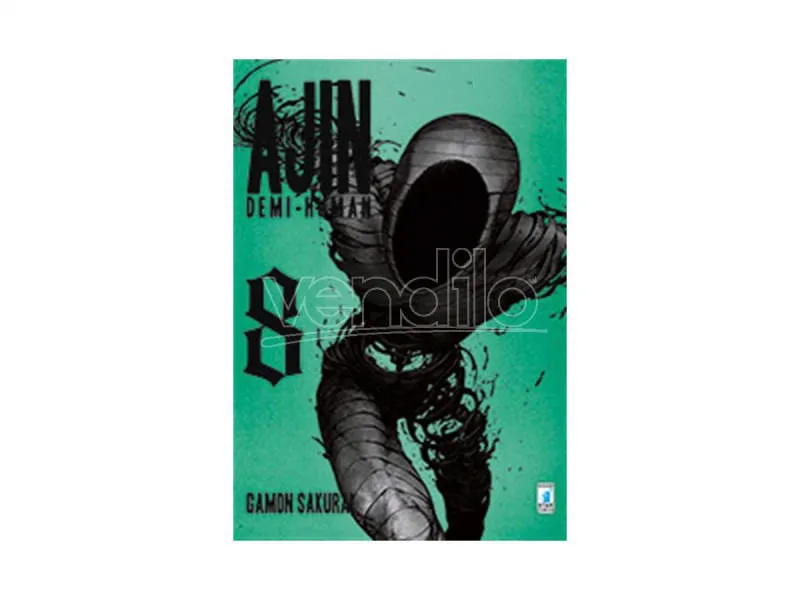
Both Ajin: Demi-Human and Chainsaw Man explore the societal implications of beings with extraordinary powers. While Chainsaw Man focuses on the dark and violent consequences of using these powers, Ajin: Demi-Human delves into the complex struggles of integration and acceptance for individuals who are ostracized for their unique abilities. Both series grapple with the theme of humanity and what it means to be considered “normal” in a world where the line between human and monster is blurred. The protagonists of both stories, Kaito and Denji, are forced to navigate a world that fears and misunderstands their true nature, ultimately leading them to question their own sense of identity and purpose.
Synopsis: Ajin: Demi-Human
Ajin: Demi-Human follows the story of Kei Nagai, a seemingly ordinary high school student who discovers he is an Ajin, a being with immortality and supernatural abilities. After a fatal accident, Kei is brought back to life with an unknown entity living within him. This revelation throws him into a chaotic world where Ajin are hunted and feared by the government.
Kei's life takes a drastic turn as he navigates the perilous world of Ajin, encountering both allies and enemies. He grapples with his newfound powers and his own identity as an Ajin while fighting against the government's relentless pursuit. The story explores themes of prejudice, discrimination, and the struggle for survival as Kei seeks answers about his existence and the true nature of the Ajin.
Deadman Wonderland

Both Deadman Wonderland and Chainsaw Man are dark fantasy manga series that delve into themes of violence, survival, and the human condition. Despite the differences in their settings and supernatural abilities, both series feature protagonists who are forced into brutal situations against their will. They navigate morally gray areas, facing difficult choices and questioning their own humanity. Both series explore the human cost of power and the corrupting nature of authority. Both also feature strong visual storytelling and visceral action sequences that leave a lasting impact on the reader.
Synopsis Deadman Wonderland
Deadman Wonderland is a Japanese manga series written by Jinsei Kataoka and illustrated by Kazuma Kondou. The story follows Ganta Igarashi, a seemingly ordinary middle school student who is framed for the massacre of his entire class and sentenced to death. Instead of execution, he is sent to the notorious Deadman Wonderland, a private prison disguised as an amusement park.
In this twisted prison, inmates compete in deadly games for a chance to earn "karma points" that can be used to purchase necessities like food and water. Ganta soon discovers that he possesses a unique power called the "Deadman" ability, which allows him to manipulate his blood into a deadly weapon. He is forced to embrace this power and participate in the gruesome games, all while searching for the truth behind the massacre and the identity of the mysterious "Wretched Egg", a powerful entity that seems to be connected to the Deadman abilities.
Parasyte
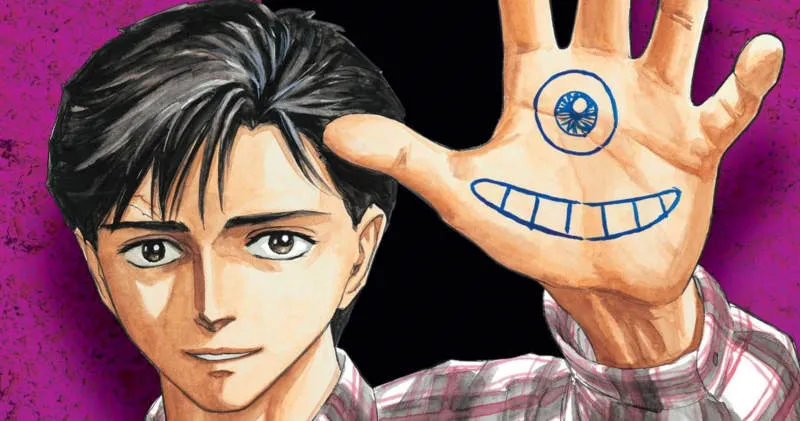
While vastly different in tone and overall themes, both Parasyte and Chainsaw Man explore similar concepts regarding the existential dread of being human and the struggle to survive in a world where the rules are constantly shifting. The parasitic aliens in Parasyte, much like the devil hybrids in Chainsaw Man, represent a threat to human society, forcing protagonists to grapple with their own humanity and the necessity of violence. Both series also touch on themes of identity, forcing characters to question their own nature and purpose as they navigate a world riddled with chaos and unpredictable dangers.
Synopsis of Parasyte
Parasyte, known in Japan as Kiseijū, is a science fiction horror manga series written and illustrated by Hitoshi Iwaaki. The story follows Shinichi Izumi, a high school student whose right hand is invaded by a parasitic alien called Migi. Migi is one of many alien parasites that have arrived on Earth and are attempting to take over human bodies by entering their brains through the nose or ears. However, Migi failed to reach Shinichi's brain and instead took over his right hand. As Migi and Shinichi learn to co-exist, they are faced with the threat of other parasites, known as "Parasites," that have successfully taken over other human bodies.
The story explores themes of survival, identity, and the nature of humanity. Shinichi and Migi must learn to work together in order to survive in a world where they are both hunted by the parasites and humans who fear them. The manga also explores the ethical implications of the parasites' existence and the question of whether they can be considered living beings or just organisms. As the story progresses, Shinichi and Migi must confront their own prejudices and learn to accept each other as they fight to protect themselves and the world from the parasitic threat.
